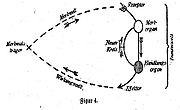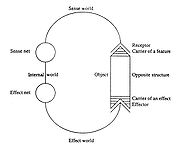
Umwelt
Encyclopedia



Jakob von Uexküll
Jakob Johann von Uexküll was a Estonian biologist who worked in the fields of muscular physiology, animal behaviour studies, and the cybernetics of life. However, his most notable contribution is the notion of umwelt, used by semiotician Thomas Sebeok...
and Thomas A. Sebeok
Thomas Sebeok
Thomas Albert Sebeok was a polymathic American semiotician and linguist.- Life and work :...
, umwelt (plural: umwelten; the German word Umwelt means "environment" or "surrounding world") is the "biological foundations that lie at the very epicenter of the study of both communication
Communication
Communication is the activity of conveying meaningful information. Communication requires a sender, a message, and an intended recipient, although the receiver need not be present or aware of the sender's intent to communicate at the time of communication; thus communication can occur across vast...
and signification
Sign (semiotics)
A sign is understood as a discrete unit of meaning in semiotics. It is defined as "something that stands for something, to someone in some capacity" It includes words, images, gestures, scents, tastes, textures, sounds – essentially all of the ways in which information can be...
in the human [and non-human] animal." The term is usually translated as "self-centered world". Uexküll theorised that organisms can have different umwelten, even though they share the same environment.
Discussion
Each functional component of an umwelt has a meaningMeaning (non-linguistic)
A non-linguistic meaning is an actual or possible derivation from sentience, which is not associated with signs that have any original or primary intent of communication...
and so represents the organism's model of the world. It is also the semiotic world of the organism, including all the meaningful aspects of the world for any particular organism, i.e. it can be water, food, shelter, potential threats, or points of reference for navigation. An organism creates and reshapes its own umwelt when it interacts with the world. This is termed a 'functional circle'. The umwelt theory states that the mind and the world are inseparable, because it is the mind that interprets the world for the organism. Consequently, the umwelten of different organisms differ, which follows from the individuality and uniqueness of the history of every single organism. When two umwelten interact, this creates a semiosphere
Semiosphere
Semiosphere is the sphere of semiosis in which sign processes operate in the set of all interconnected Umwelten. The concept was first coined by Juri Lotman in 1982 and is now applied to many fields, including cultural semiotics generally, biosemiotics, zoosemiotics, geosemiotics, etc...
.
As a term, umwelt also unites all the semiotic processes of an organism into a whole. Internally, an organism is the sum of its parts operating in functional circles and, to survive, all the parts must work together co-operatively. This is termed the 'collective umwelt' which models the organism as a centralised system from the cellular level upward. This requires the semiosis
Semiosis
Semiosis is any form of activity, conduct, or process that involves signs, including the production of meaning. Briefly – semiosis is sign process...
of any one part to be continuously connected to any other semiosis operating within the same organism. If anything disrupts this process, the organism will not operate efficiently. But, when semiosis operates, the organism exhibits goal-oriented or intentional behaviour.
There are also parallels between the concept of Umwelt and Richard Dawkin's idea of the Extended Phenotype.
Uexküll's writings show a specific interest in the various worlds that he believed to exist ('conceptually') from the point of view of the Umwelt of different creatures such as tick
Tick
Ticks are small arachnids in the order Ixodida, along with mites, constitute the subclass Acarina. Ticks are ectoparasites , living by hematophagy on the blood of mammals, birds, and sometimes reptiles and amphibians...
s, sea urchin
Sea urchin
Sea urchins or urchins are small, spiny, globular animals which, with their close kin, such as sand dollars, constitute the class Echinoidea of the echinoderm phylum. They inhabit all oceans. Their shell, or "test", is round and spiny, typically from across. Common colors include black and dull...
s, amoebae, jellyfish
Jellyfish
Jellyfish are free-swimming members of the phylum Cnidaria. Medusa is another word for jellyfish, and refers to any free-swimming jellyfish stages in the phylum Cnidaria...
and sea worms.
The biosemiotic turn in Jakob von Uexküll's analysis occurs in his discussion of the animal's relationship with its environment. The umwelt is for him an environment-world which is (according to Agamben), "constituted by a more or less broad series of elements [called] "carriers of significance" or "marks" which are the only things that interest the animal". Agamben goes on to paraphrase one example from Uexküll's discussion of a tick, saying,
"...this eyeless animal finds the way to her watchpoint [at the top of a tall blade of grass] with the help of only its skin’s general sensitivity to light. The approach of her prey becomes apparent to this blind and deaf bandit only through her sense of smell. The odor of butyric acid, which emanates from the sebaceous follicles of all mammals, works on the tick as a signal that causes her to abandon her post (on top of the blade of grass/bush) and fall blindly downward toward her prey. If she is fortunate enough to fall on something warm (which she perceives by means of an organ sensible to a precise temperature) then she has attained her prey, the warm-blooded animal, and thereafter needs only the help of her sense of touch to find the least hairy spot possible and embed herself up to her head in the cutaneous tissue of her prey. She can now slowly suck up a stream of warm blood."
Thus, for the tick, the umwelt is reduced to only three (biosemiotic) carriers of significance: (1) The odor
Odor
An odor or odour is caused by one or more volatilized chemical compounds, generally at a very low concentration, that humans or other animals perceive by the sense of olfaction. Odors are also commonly called scents, which can refer to both pleasant and unpleasant odors...
of butyric acid
Butyric acid
Butyric acid , also known under the systematic name butanoic acid, is a carboxylic acid with the structural formula CH3CH2CH2-COOH. Salts and esters of butyric acid are known as butyrates or butanoates...
, which emanates from the sebaceous follicles of all mammals, (2) The temperature
Temperature
Temperature is a physical property of matter that quantitatively expresses the common notions of hot and cold. Objects of low temperature are cold, while various degrees of higher temperatures are referred to as warm or hot...
of 37 degrees celsius
Celsius
Celsius is a scale and unit of measurement for temperature. It is named after the Swedish astronomer Anders Celsius , who developed a similar temperature scale two years before his death...
(corresponding to the blood
Blood
Blood is a specialized bodily fluid in animals that delivers necessary substances such as nutrients and oxygen to the cells and transports metabolic waste products away from those same cells....
of all mammals), (3) The hairy typology
Typology
Typology is the study of types. More specifically, it may refer to:*Typology , division of culture by races*Typology , classification of things according to their characteristics...
of mammals.
Critics
Uexküll's application of the notion of "umwelt" to the human person has been contested. In "Welt and Umwelt" and "Die Wahrheit der Dinge" the philosopher and sociologist Josef PieperJosef Pieper
Josef Pieper was a German Catholic philosopher, at the forefront of the Neo-Thomistic wave in twentieth century Catholic philosophy. Among his most notable works are The Four Cardinal Virtues: Prudence, Justice, Fortitude, Temperance; Leisure: the Basis of Culture; The Philosophical Act and Guide...
argued that reason allows the human person to live in "welt" (world) while plants and animals do indeed live in an Umwelt — a notion which he traces back far beyond Uexküll to Plato
Plato
Plato , was a Classical Greek philosopher, mathematician, student of Socrates, writer of philosophical dialogues, and founder of the Academy in Athens, the first institution of higher learning in the Western world. Along with his mentor, Socrates, and his student, Aristotle, Plato helped to lay the...
, Aristotle
Aristotle
Aristotle was a Greek philosopher and polymath, a student of Plato and teacher of Alexander the Great. His writings cover many subjects, including physics, metaphysics, poetry, theater, music, logic, rhetoric, linguistics, politics, government, ethics, biology, and zoology...
, and Thomas Aquinas
Thomas Aquinas
Thomas Aquinas, O.P. , also Thomas of Aquin or Aquino, was an Italian Dominican priest of the Catholic Church, and an immensely influential philosopher and theologian in the tradition of scholasticism, known as Doctor Angelicus, Doctor Communis, or Doctor Universalis...
.
See also
- Cognized environmentCognized environmentCognized environment is a concept first introduced by the late anthropologist, Roy Rappaport , in contrast to what he called the operational environment . Rappaport was an ecological anthropologist, like Andrew P...
- Existential TherapyExistential therapyExistential psychotherapy is a philosophical method of therapy that operates on the belief that inner conflict within a person is due to that individual's confrontation with the givens of existence. These givens, as noted by Irvin D...
- Reality tunnelReality tunnelReality tunnel is a term coined by Timothy Leary and popularised by Robert Anton Wilson , akin to the idea of representative realism....
- Weltanschauung
External links
- Umwelt by John DeelyJohn DeelyJohn Deely is an American philosopher and semiotician. He is a Professor of Philosophy at the Center for Thomistic Studies of the University of St. Thomas ....
- Umwelt and semiosphere by Kalevi KullKalevi KullKalevi Kull is an eminent biosemiotics professor at the University of Tartu, Estonia.He was the president of the Estonian Naturalists' Society in 1991–1994.Ecologist Olevi Kull was his younger brother.-Publications:...
- Pragmatism and Umwelt-theory by Alexei Sharov

